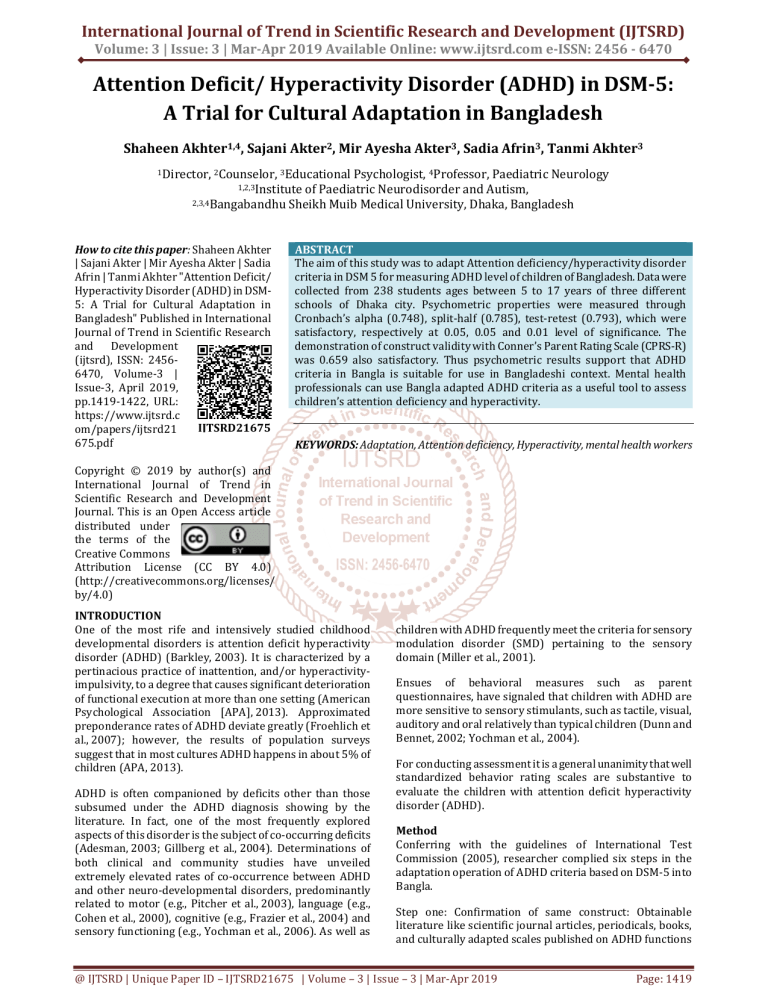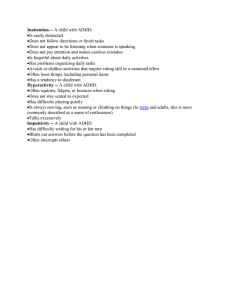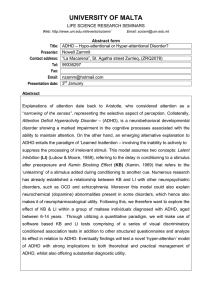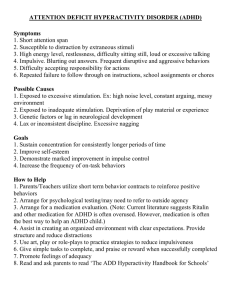
International Journal of Trend in Scientific Research and Development (IJTSRD)
Volume: 3 | Issue: 3 | Mar-Apr 2019 Available Online: www.ijtsrd.com e-ISSN: 2456 - 6470
Attention Deficit/ Hyperactivity Disorder (ADHD) in DSM-5:
A Trial for Cultural Adaptation in Bangladesh
Shaheen Akhter1,4, Sajani Akter2, Mir Ayesha Akter3, Sadia Afrin3, Tanmi Akhter3
1Director, 2Counselor, 3Educational
Psychologist, 4Professor, Paediatric Neurology
1,2,3Institute of Paediatric Neurodisorder and Autism,
2,3,4Bangabandhu Sheikh Muib Medical University, Dhaka, Bangladesh
How to cite this paper: Shaheen Akhter
| Sajani Akter | Mir Ayesha Akter | Sadia
Afrin | Tanmi Akhter "Attention Deficit/
Hyperactivity Disorder (ADHD) in DSM5: A Trial for Cultural Adaptation in
Bangladesh" Published in International
Journal of Trend in Scientific Research
and Development
(ijtsrd), ISSN: 24566470, Volume-3 |
Issue-3, April 2019,
pp.1419-1422, URL:
https://www.ijtsrd.c
IJTSRD21675
om/papers/ijtsrd21
675.pdf
ABSTRACT
The aim of this study was to adapt Attention deficiency/hyperactivity disorder
criteria in DSM 5 for measuring ADHD level of children of Bangladesh. Data were
collected from 238 students ages between 5 to 17 years of three different
schools of Dhaka city. Psychometric properties were measured through
Cronbach’s alpha (0.748), split-half (0.785), test-retest (0.793), which were
satisfactory, respectively at 0.05, 0.05 and 0.01 level of significance. The
demonstration of construct validity with Conner’s Parent Rating Scale (CPRS-R)
was 0.659 also satisfactory. Thus psychometric results support that ADHD
criteria in Bangla is suitable for use in Bangladeshi context. Mental health
professionals can use Bangla adapted ADHD criteria as a useful tool to assess
children’s attention deficiency and hyperactivity.
KEYWORDS: Adaptation, Attention deficiency, Hyperactivity, mental health workers
Copyright © 2019 by author(s) and
International Journal of Trend in
Scientific Research and Development
Journal. This is an Open Access article
distributed under
the terms of the
Creative Commons
Attribution License (CC BY 4.0)
(http://creativecommons.org/licenses/
by/4.0)
INTRODUCTION
One of the most rife and intensively studied childhood
developmental disorders is attention deficit hyperactivity
disorder (ADHD) (Barkley, 2003). It is characterized by a
pertinacious practice of inattention, and/or hyperactivityimpulsivity, to a degree that causes significant deterioration
of functional execution at more than one setting (American
Psychological Association [APA], 2013). Approximated
preponderance rates of ADHD deviate greatly (Froehlich et
al., 2007); however, the results of population surveys
suggest that in most cultures ADHD happens in about 5% of
children (APA, 2013).
ADHD is often companioned by deficits other than those
subsumed under the ADHD diagnosis showing by the
literature. In fact, one of the most frequently explored
aspects of this disorder is the subject of co-occurring deficits
(Adesman, 2003; Gillberg et al., 2004). Determinations of
both clinical and community studies have unveiled
extremely elevated rates of co-occurrence between ADHD
and other neuro-developmental disorders, predominantly
related to motor (e.g., Pitcher et al., 2003), language (e.g.,
Cohen et al., 2000), cognitive (e.g., Frazier et al., 2004) and
sensory functioning (e.g., Yochman et al., 2006). As well as
children with ADHD frequently meet the criteria for sensory
modulation disorder (SMD) pertaining to the sensory
domain (Miller et al., 2001).
Ensues of behavioral measures such as parent
questionnaires, have signaled that children with ADHD are
more sensitive to sensory stimulants, such as tactile, visual,
auditory and oral relatively than typical children (Dunn and
Bennet, 2002; Yochman et al., 2004).
For conducting assessment it is a general unanimity that well
standardized behavior rating scales are substantive to
evaluate the children with attention deficit hyperactivity
disorder (ADHD).
Method
Conferring with the guidelines of International Test
Commission (2005), researcher complied six steps in the
adaptation operation of ADHD criteria based on DSM-5 into
Bangla.
Step one: Confirmation of same construct: Obtainable
literature like scientific journal articles, periodicals, books,
and culturally adapted scales published on ADHD functions
@ IJTSRD | Unique Paper ID – IJTSRD21675 | Volume – 3 | Issue – 3 | Mar-Apr 2019
Page: 1419
International Journal of Trend in Scientific Research and Development (IJTSRD) @ www.ijtsrd.com eISSN: 2456-6470
were confabbed to ascertain whether the constructs of the
original ADHD function carry the same meanings for
Bangladeshi people and their culture. Panels of experts (who
are comrade on ADHD criteria and test adaptation) were
involved to accomplish the construct equivalence. They
evaluate each and every items of the scale and ensure its
conceptions similarity. All of their judgments were adhering
a unanimity was found which fetch that the construct under
the current study really do exist. The experts also
recommend that the same definition could be equally
applicable to language and cultural group of Bangladesh.
Step two: Forward translation: For rend the original RFS
from English to Bangla, 2 professional translators, who are
graduated from English department of Dhaka University,
were picked out and they were absolutely dim about who the
other person is doing translation. Translators’ mother
tongue has to be Bangla and they have to be familiar with
American language, literature, and culture both criteria were
followed before selection of the translators. They
independently translated the English version of the criteria
of ADHD to Bangla without consulting one another. Both of
the translators put much iterative effort in selecting the best
words, expressions, or items to translate their respective
translated versions. Hence, the preliminary Bangla version
inventory was prepared. Soon afterward a professor of
Linguistics from University of Dhaka was conferred to check
for the language and sentence structure and quality of
translation, and conceptual equivalence of words or phrases,
but not a word-for-word translation. Tracing the expert’s
opinion, some modifications were done which uphold the
items’ expression, suitability to assess the construct in
Bangladeshi culture.
Step three: Back translation: Again three professional
translators were enrolled who without consulting one
another severally translated the Bangla version of the ADHD
criteria to English. The translators’ mother tongue was
Bangla, but their medium of education was English. As a
result, all of them belong to a good command in both English
and Bangla language and they were assigned to the task of
translating the Bangla version into English. A panel
comprising of three members having expertise in
psychometrics and proficiency in English judged the
equivalence of the original English version and the backtranslated version of the ADHD criteria. High degree of
unanimity among the panel members was observed and the
back-translated version of the ADHD criteria was found to be
very much like the original one which sinaling the
correctness of forward translation. The Bangla version was
then conceived as fix to use for next processes.
Step four: Pre-testing and cognitive interviewing: Before
administering the finalized Bangla version of ADHD to a
large group of sample a pre-test was accomplished on a
group of 30 convenient samples which let in male and female
(age range 6 to 18 years) having rural urban composition.
Objectives and significance were conveyed to the
participants and their parents before they took part in this
study. Participants and their parents who showed their sake
were selected as participants. To have primary validity
evidence for each of the of ADHD criteria, three methods
were hired videlicet, the scale administration, semistructured interview and item analysis. Scale administrationIn this part of the study translated Bangla version of ADHD
criteria was administered to the respondents in convenient
session in IPNA. A group of 3 educational psychologists and
1 counselor who are trained for assessment, observation
techniques and data collection were employed to administer
this scale. All of them were trained well before the
administration. At first, informed consents were taken and
then participants were asked to read the instructions on the
top of the ADHD criteria very carefully. Then participants
were also orally taught to make it clear what they have to do
here. They were made insured that the information collected
from them would be kept strictly confidential and would be
used only for the research purpose. The questionnaire was
doled out individually to each parent. They were instructed
to answer every question honestly and to select only one
response for each question. Participant’s responses to each
item indicate how frequently the statement was true for
their child. They were instructed that if their answer is
NEVER for any statement of the questionnaire they have to
rate that statement as 0, If their answer is RARELY rate as 1,
OFTEN as 2, and if their answer is VERY FREQUENTLY they
have to rate the statement as 3 where there is nothing as
right or wrong answer here. They were told to answer as
truthfully as possible and work relatively quickly. The
participants were accorded to ask questions about words or
concepts which they did not understand during the
administration period. Then the words, expressions or
sentences that the participants asked about were noted to
check whether it was necessary to modify them.
Approximately 15-20 minutes were taken by the
participants to complete their task. Interview- To find out
whether any word, concept, or expression that needs to be
addressed further because of its difficulty, confusion, un
acceptableness or offensiveness, the present study used
person to person interview method. If there is anything that
participants do not understand or confusing, they were
expected to put their alternatives or they were asked “how
would you ask the question if you were prepare this item?”
Through this procedure contextualization of their language
was make ensure. Item analysis-afterwards the completion
of administering the scale, participant’s responses in each
item were analyzed to determine corrected item-to-total
correlation which indicated the appropriateness of each
item. To sort it out which items are not able to measure what
the whole scale is supposed to measure, item to total score
correlation was calculated. And items which show low or
negative correlation were paid extra attention and modified.
Item analyses for this questionnaire revealed that a total of 5
items had low positive correlation and 4 items had negative
correlation with total score. Interestingly, these were the
items which the respondents found baffling and difficult.
However, internal consistency reliability (alpha coefficient)
for each factor was good ranging from .49 to .72. The panel
members who worked in the back translation phase as
evaluators had modified the language of the defective items
in unanimities with each other.
Step five: Pre-testing II: Again following two methods
namely scale administration and item analysis, the revised
overture Bangla version of ADHD was administered on
couple of respondents as second pre-testing. Scale
administration- A total of 44 samples (age range 4-18; 46%
male and 54% female; 30% rural and 70% urban) were
selected purposively following convenient sampling method
to administer the whole scale. Same procedure like the first
pre-testing was followed this time for scale administration
and data collection. Item analysis - Item analysis in the
second pre-testing showed a marked improvement from
@ IJTSRD | Unique Paper ID - IJTSRD21675 | Volume – 3 | Issue – 3 | Mar-Apr 2019
Page: 1420
International Journal of Trend in Scientific Research and Development (IJTSRD) @ www.ijtsrd.com eISSN: 2456-6470
statistical as well as conceptual framing. Internal consistency
of the whole scale ranged from .69 to .89 which better in
comparison to first pre-testing. On the other hand,
satisfactory levels of corrected item-to-total correlation
coefficients were observed for almost all the items except for
two items. Then these items were revised once again
through expert opinion and included in the main scale and
then continued for field test.
Step six: Field test: Following confirmed from two times of
the pre-tests, now the Bangla version of ADHD is absolutely
applicable for the Bangladeshi population, a field test was
carried out to determine reliability and validity of the Bangla
version ADHD scale. Purposive and convenience sampling
technique was used to collect data from 256 students three
different schools of Dhaka city (after data cleaning finally
238 respondents retained for data analysis) aged between 5
years and 17 years. Although nature of the sampling was
incidental but one inclusion criteria were applied during
sample selection had no severe physical or mental condition
that might interfere with the assessment.
Result and Discussion
The study included 238 children (149 males, 89 females)
with a mean age of 8 years (range 5 to 17 years). Of these
238 children, 190 (79.8%) were 5 years of age or older.
Proportion according to educational background of the
whole sample, 70 (29.4%) had started schooling recently, 96
(40.3%) were in primary education, and 72 (30.3%) had
continued education in secondary level.
Descriptive statistics of the study variables show that the
mean score for all 238 respondents was 56.41 with a
standard deviation of 6.587. The lowest possible score is 0
and highest possible score is 60.
The corrected item-total correlation coefficients presented
in table 1 show highly significant correlation coefficient
values for all items except one item (item no 5). This item
was revised. High Alpha coefficient value was indicative of
high internal consistency (Table 2). The test-retest reliability
coefficient (0.793) also shows stability of the scale over time.
Items of
ADHD criteria
Item 1
Item 2
Item 3
Item 4
Item 5
Item 6
Item 7
Item 8
Item 9
Item 10
Item 11
Item 12
Item 13
Item 14
Item 15
Item 16
Item 17
Item 18
Item 19
Item 20
Table 1:
Corrected itemtotal Correlation
0.440
0.332
0.273
0.167
0.371
0.313
0.251
0.418
0.361
0.271
0.382
0.373
0.372
0.394
0.458
0.428
0.389
0.432
0.396
0.321
Cronbach’s alpha
if item deleted
0.726
0.738
0.741
0.757
0.736
0.758
0.733
0.748
0.726
0.738
0.747
0.728
0.722
0.731
0.738
0.728
0.739
0.737
0.732
0.738
Table 2: Reliability coefficient of the Bangla version of
ADHD criteria
Split-half
Cronbach’s
Testreliability
alpha
retest
Scale
coefficient
reliability
reliability
(Spearmancoefficient
coefficient
Brown)
ADHD
criteria
0.748*
0.785*
0.793**
based on
DSM 5
**p<0.01 and *p<0.05
Inter-judge agreement about the content of the Bangla scale
was indicative of the content validity. Construct validity
(Table 3) was tested by correlating the Bangla ADHD criteria
with Conner’s Parent Rating Scale (CPRS-R) using a
Pearson’s Bivariate correlation. There was a significant
positive correlation between the ADHD and the Conner’s
Parent rating scale (r=0.659, N=238, P<0.05).
Table 3: Pearson correlation for construct validity
Conner’s Parent Rating
Scale (CPRS-R)
ADHD criteria based
on DSM 5
0.659**
**p<0.01
Thus the adapted Bangla scale proved to be a reliable and
valid measure of ADHD criteria meeting the benchmark
criteria set out for adapting measures. Overall the scale
should provide educational and medical professionals with
concise and robust measure of ADHD that can assess the
child’s hyperactive behavior and interventions for the
children. The study has a number of recommendations. The
instrument needs to be further tested in larger and more
diverse populations with qualitative measures. Also with
further research the scale’s sensitivity and discriminate
validity can be established and from which some diagnostic
features may emerge.
Reference
[1] Adesman A. (2003). A diagnosis of ADHD? Don't
overlook the probability of comorbidity. Contemp.
Pediatric. 20, 91–112
[2] APA (2013). Diagnostic and Statistical Manual of
Mental Disorders, Fifth Edition. DSM-5. American
Psychiatric Association: Washington, DC.
[3] Barkley R. A. (2003). Issues in the diagnosis of
attention
deficit/hyperactivity
disorder
in
children. Brain Dev. 25, 77–83
[4] Cohen N. J., Vallance D. D., Barwick M., Im N., Menna R.,
Horodezky N. B. (2000). The interface between ADHD
and language impairment: an examination of language,
achievement and cognitive processing. J. Child Psychol.
Psychiatry 41, 353–362
[5] Dunn W., Bennet D. (2002). Patterns of sensory
processing in children with attention deficit
hyperactivity disorder. Occup. Ther. J. Res. 22, 4–15
[6] Frazier T. W., Demaree H. A., Youngstrom E. A.
(2004). Meta-analysis
of
intellectual
and
neuropsychological test performance in attention
@ IJTSRD | Unique Paper ID - IJTSRD21675 | Volume – 3 | Issue – 3 | Mar-Apr 2019
Page: 1421
International Journal of Trend in Scientific Research and Development (IJTSRD) @ www.ijtsrd.com eISSN: 2456-6470
deficit/hyperactivity disorder. Neuropsychology 18,
543–555
intervention. Eur. Child Adolesc. Psychiatry13Suppl. 1,
S80–S92
[7] Froehlich E., Lanphear B. P., Epstein J. N., Barbaresi W.
J., Katusic S. K., Kahn R. S. (2007). Prevalence,
recognition,
and
treatment
of
attentiondeficit/hyperactivity disorder in a national sample of
US children. Arch. Pediatr. Adolesc. Med. 161, 857–864
[9] Miller J. L., Nielson M. D., Schoen A. S. (2012). Attention
deficit hyperactivity disorder and sensory modulation
disorder: a comparison of behavior and
physiology. Res. Dev. Disabil. 33, 804–818
[8] Gillberg C., Gillberg C. I., Rasmussen P., Kadesjo B.,
Soderstrom H., Rastam M. (2004). Co-existing disorders
in
ADHD—implications
for
diagnosis
and
[10] Yochman A., Ornoy A., Parush S. (2006). Co-occurrence
of developmental delays among preschool children
with attention-deficit-hyperactivity disorder. Dev. Med.
Child Neurol. 48, 483–488
@ IJTSRD | Unique Paper ID - IJTSRD21675 | Volume – 3 | Issue – 3 | Mar-Apr 2019
Page: 1422





